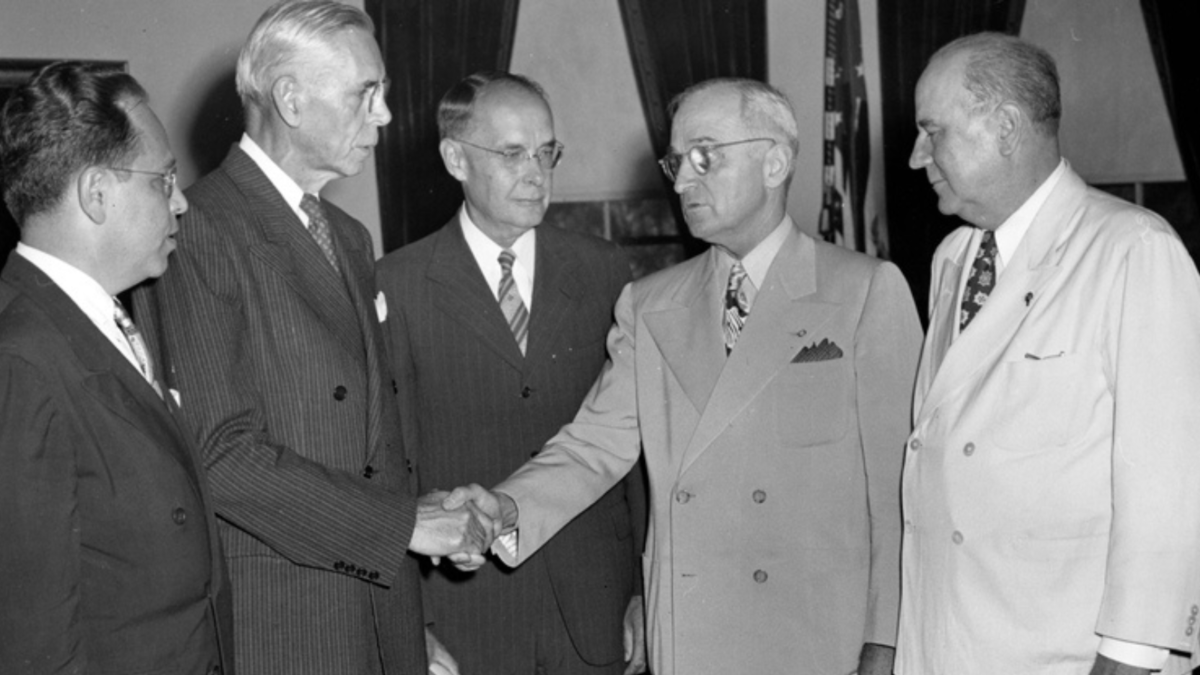My father’s table: Two hands are better than one
Soon after World War II, and with a mandate to restart the crippled US economy, President Harry Truman was quoted as saying: “Give me a one handed economist”. Having no access to computer power or corresponding econometric algorithms, economists posed their recommendations under more balanced terms, e.g. “On the one hand the economy may do this, on the other hand it may do that.”. Tasked with this massive responsibility, it’s understandable that Truman wanted certainty within an inexact social science called “economics”.
This desire to embrace certainty from within uncertainty never waned, albeit perhaps overlooked as our computer power grew exponentially under “Moore’s Law”, thereby giving economic forecasters the ability to process larger amounts of data and improve the efficacy of new econometric models. And while this improvement was obviously welcomed, it nonetheless bred a false sense of comfort as we stopped questioning the economic inputs and started accepting the outputs as sacrosanct.
You don’t have to be a Nobel-winning academic from Long-Term Capital Management to realise that there is no such thing as an infallible algorithm. Any first year statistics student understands that any model is only as good as its inputs, an academic prudence often expressed through the acronym GIGO (Garbage In, Garbage Out). Statistical and econometric models are only as good as the inputs and circumstances they’re regressed under. So before any model is executed it’s prudent to ask oneself, “Where is this model wrong?”
In years to come, academic textbooks will no doubt write about how wrong central banks were in blindly implementing econometric results without asking, “Where are our models wrong?” Such an error, however, is not unique to central bankers as it was equally made by the wider community; policy writers, media, banks and mortgage providers, and of course, investors. And while it’s become fashionable to criticise only central banks, with some governments looking to impose greater central bank oversight and scrutiny, is this really fair given that those rock throwing glass house dwellers are equally wrong by not challenging their own assumptions and outputs?
It was never a question of how high interest rates will rise. It’s how will the unwinding of QE impact real asset prices as repayment costs return to previous historical levels while borrowers and retired real asset owners assumed they wouldn’t.
Consider the following. At the end of WWII, the global economy slowly returned to some semblance of “normalcy”. During the war, factories moved from manufacturing widgets to manufacturing tanks. Labour (predominantly male) went from the assembly line to the front line. Government spending went from buying bombs to building new domestic infrastructure. Previously closed U-boat infested trade routes reopened. The world readjusted from a closed/controlled war economy to an open and liberal one. All this heightened and reactivated economic activity pushed inflation to previously unseen levels.
During the war, US inflation hovered between two to four per cent. Immediately post war, however, US inflation rose to an astonishing 18 per cent in 1946 and another nine per cent by 1947. And what did US interest rates do during this period? Nothing. T-Bill yields didn’t break two per cent and long bonds hovered under three per cent until the mid-1950s. There was barely any change in monetary policy, though some structural and policy changes were implemented. The “other” hand, which Truman yearned to amputate, served its purpose by handcuffing the first hand from imposing an unnecessary tightening of monetary policy as inflation eventually dropped down once economic post war normalcy returned. And while it’s also true that fiscal policy had tightened to a top marginal tax rate of around 90 per cent (pay down the war debt), such restrictive fiscal policy only impacted the top one per cent, and America had a thriving and growing middle class.
Plus ca change?
There are visible differences between post war 1946/1947 and today, but both times the global economy was shut and moved into a “war economy” status (where only essentials were allowed to operate). Unlike then, however, our attempt to reopen our economy was further impeded by the Ukraine/Russia war (and its pending energy and grain crisis). Nonetheless, factories began to reopen, along with previously closed trade routes, to changes within labour and work practice.
The most visible difference between then and now is that central banks today began to unwind uber-stimulatory monetary policy. Another anomaly often overlooked was that during the pandemic oil prices had fallen to an equally unprecedented $0.00 (in fact even turned negative as physical storage cost pushed net oil prices to negative dollar cost).
These notable differences between then and now, with zero per cent cash rates and -$0.00 oil prices, receive next to no mention when concerns around today’s inflation are raised. It’s as if many of us assumed such levels would continue into perpetuity, and unwilling to discuss the asset inflation QE fuelled as investors sought any yield over zero per cent cash rates.
Even though economic and political concerns around COVID were obviously bearish, shares, property, and other real asset prices rallied as the weight of money was redirected from single digit basis point term rates towards higher yielding (but more risky) real assets. Instead of raising concerns around how unsustainable all this was, too many of us viewed such price rallies as indicative of market approval of how governments and central banks were managing Covid’s war-like economy. QE’s efficacy was less in stimulating the economy than it was in pushing up real asset prices to unsustainable levels: a real asset bubble.
If there was a failure it’s one we all share. QE (or its longevity) was a failure. Instead of stimulating the economy (as one would assume given zero cost funding), the only effect it had was in creating a real asset bubble, particular one delivering a yield. Was it really a surprise that interest rates would rise, or that oil prices wouldn’t stay at -$0.00?
It was never a question of how high interest rates will rise. It’s how will the unwinding of QE impact real asset prices as repayment costs return to previous historical levels while borrowers and retired real asset owners assumed they wouldn’t. And if QE didn’t stimulate the economy as expected, why then are we assuming that a tightening of interest rates will push inflation down? If you think oil prices are high now, wait until the Chinese fully open their economy while the Ukraine/Russia war continues.
A two handed economist is one who prudently embraces statistics, but does so with an understanding of their fallibility. One hand is the statistics, while the second hand is the story around where the statistics came from. Understanding both should be desired, not shunned. Yes inflation is high, but wasn’t this rise inevitable given historically relevant unwinding from the previous war economy post WWII? As for the recession, and to paraphrase Paul Keating, this is one we didn’t need to have.
My Father’s Table is a recurring column penned by Rob Prugue. The previous instalment can be found here.










